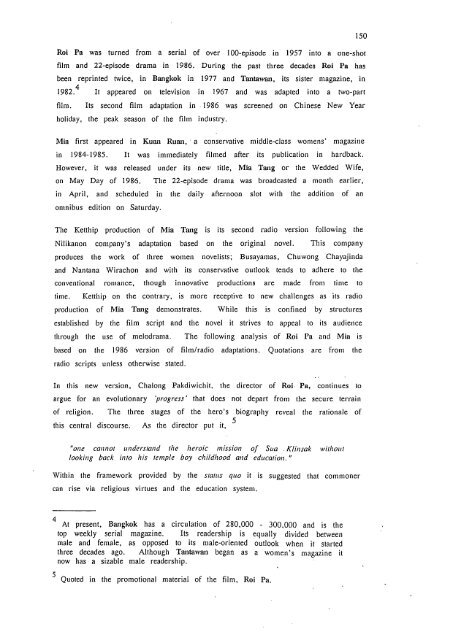iieiiei1eWrkers - Leicester Research Archive - University of Leicester
iieiiei1eWrkers - Leicester Research Archive - University of Leicester
iieiiei1eWrkers - Leicester Research Archive - University of Leicester
You also want an ePaper? Increase the reach of your titles
YUMPU automatically turns print PDFs into web optimized ePapers that Google loves.
Roi Pa was turned from a serial <strong>of</strong> over 100-episode in 1957 into a one-shot<br />
film and 22-episode drama in 1986. During the past three decades Roi Pa has<br />
been reprinted twice, in Bangkok in 1977 and Tantawan, its sister magazine, in<br />
1982. It appeared on television in 1967 and was adapted into a two-part<br />
film. Its second film adaptation in 1986 was screened on Chinese New Year<br />
holiday, the peak season <strong>of</strong> the film industry.<br />
Mm first appeared in Kuan Ruan, a conservative middle-class womens' magazine<br />
in 1984-1985. It was immediately filmed after its publication in hardback.<br />
However, it was released under its •new title, Mia Tang or the Wedded Wife,<br />
on May Day <strong>of</strong> 1986. The 22-episode drama was broadcasted a month earlier,<br />
in April, and scheduled in the daily afternoon slot with the addition <strong>of</strong> an<br />
omnibus edition on Saturday.<br />
The Ketthip production <strong>of</strong> Mia Tang is its second radio version following the<br />
Nilikanon company's adaptation based on the original novel. This company<br />
produces the work <strong>of</strong> three women novelists; Busayamas, Chuwong Chayajinda<br />
and Nantana Wirachon and with its conservative outlook tends to adhere to the<br />
conventional romance, though innovative productions are made from tinie to<br />
time. Ketthip on the contrary, is more receptive to new challenges as its radio<br />
production <strong>of</strong> Mia Tang demonstrates. While this is confined by structures<br />
established by the film script and the novel it strives to appeal to its audience<br />
through the use <strong>of</strong> melodrania. The following analysis <strong>of</strong> Roi Pa and Mm is<br />
based on the 1986 version <strong>of</strong> film/radio adaptations. Quotations are from the<br />
radio scripts unless otherwise stated.<br />
In this new version, Chalong Pakdiwichit, the director <strong>of</strong> Roi . Pa, continues to<br />
argue for an evolutionary 'pro,qress' that does not depart from the secure terrain<br />
<strong>of</strong> religion. The three stages <strong>of</strong> the hero's biography reveal the rationale <strong>of</strong><br />
this central discourse. As the director put it,<br />
"one cannot understand the heroic mission <strong>of</strong> Sua Kfinsak without<br />
looking l,ack into his temple boy childhood and education."<br />
Within the framework provided by the status quo it is suggested that commoner<br />
can rise via religious virtues and the education system.<br />
At present, Bangkok has a circulation <strong>of</strong> 280,000 - 300,000 and is the<br />
top weekly serial magazine. Its readership is equally divided between<br />
male and female, as opposed to its male-oriented outlook when it started<br />
three decades ago. Although Tantawan began as a women's magazine it<br />
now has a sizable male readership.<br />
Quoted in the promotional material <strong>of</strong> the film, Rol Pa.<br />
150














